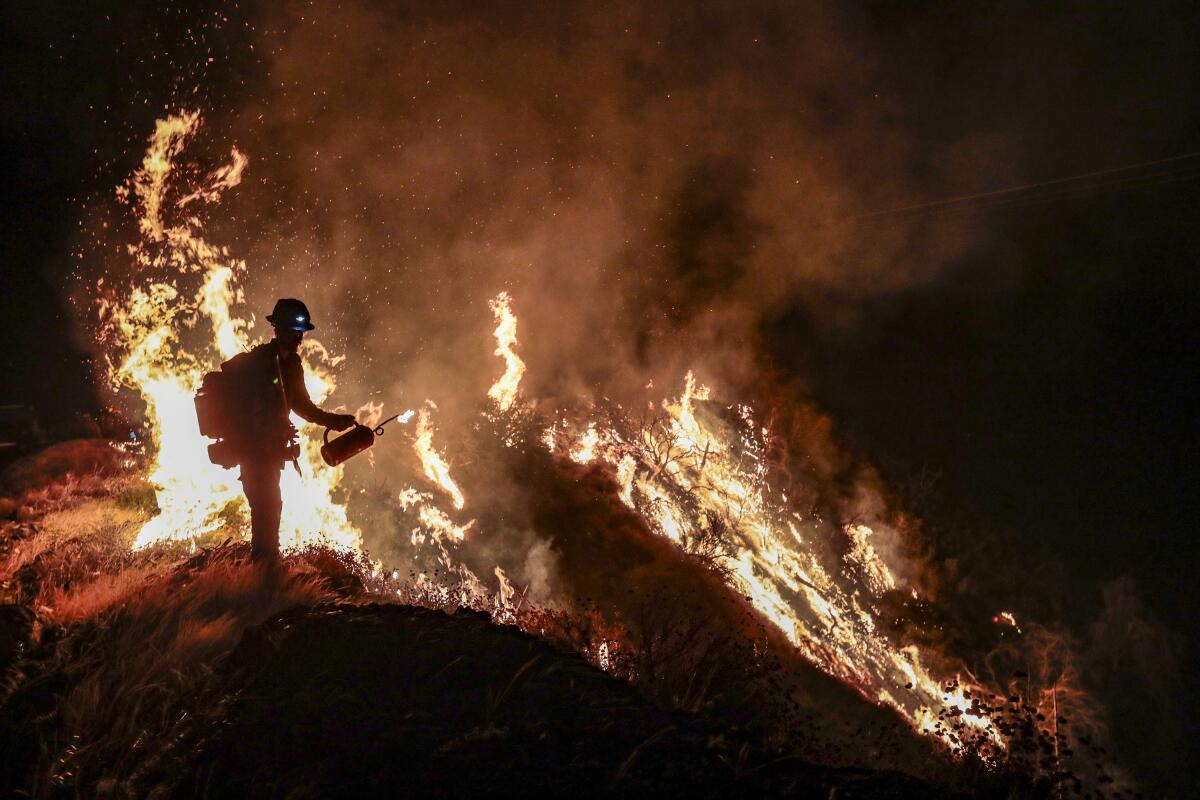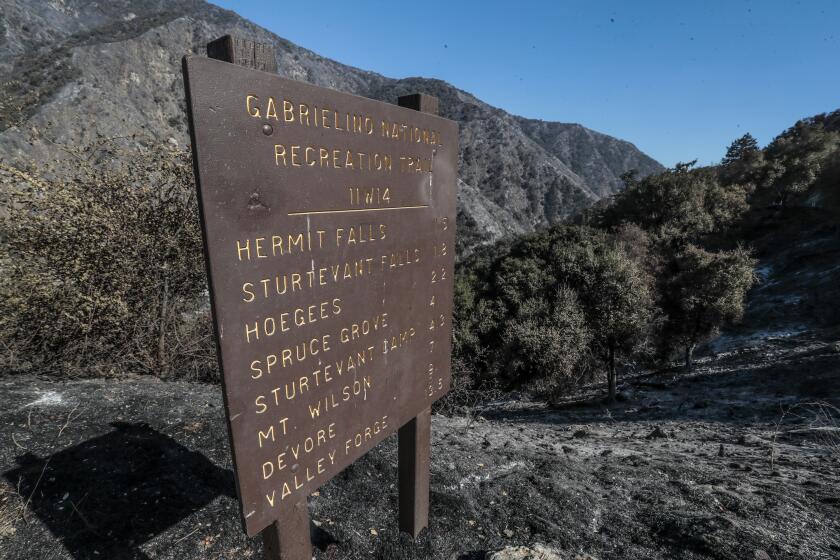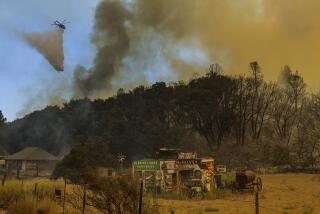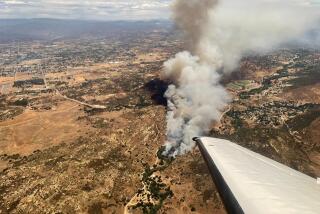Crews ‘turn a corner’ in Bobcat fire as containment doubles

Beleaguered fire crews made significant progress overnight on the Bobcat fire burning in northeastern Los Angeles County.
After weeks of struggling to keep up with the fire’s erratic, multidirectional growth, crews had achieved 38% containment of the blaze as of Wednesday morning — more than doubling the fire’s containment from the previous day.
“Today we had a pretty successful day,” said Kerri Gilliland, of the California Interagency Incident Management Team organizing the battle against the Bobcat fire, in a Tuesday evening update.
Crews successfully placed several direct containment lines — barriers created with bulldozers and mechanical equipment to hinder the spread of flames — along the fire’s edge, Gilliland said.
The fire’s growth is also slowing. After ballooning to twice its size in the course of one week, it is now increasing in slower increments, growing by a little more than 1,000 acres overnight. The total acreage burned Wednesday was 113,307, according to the U.S. Forest Service.
Progress was so significant that the estimated containment date for the fire has been moved up by one month, to Sept. 30.
“We finally got the resources, we got favorable weather, and the fuel transition was big,” Forest Service spokesman Larry Smith said Wednesday. “Once it came out of the really steep timber [of the Angeles National Forest], we were able to get more mechanized.”
The northern portion of the fire, which seared through the foothills community of Juniper Hills and portions of the Antelope Valley, has been marked as contained, Smith said.
But the fight is not over. Mt. Wilson, home to an observatory and a reported $1 billion worth of communications towers, remains threatened by the fire, which is considered one of the largest in L.A. County history.
Still, fire crews’ progress atop Mt. Wilson held steady Wednesday afternoon. Pockets of terrain were smoldering, but few immediate flames were apparent.
“The weather finally cooperated,” said Capt. Dave Gillotte of the L.A. County Fire Department. “We were finally able to see the fire and to get to the fire.”
The rugged landscape was painted with a stark mix of bright pink fire retardant and blackened trees, but the sky above the observatory was clear despite the lingering smell of smoke. Gillotte attributed much of the crews’ recent gains to hard work and preparation.
“We’ve been making a stand at Mt. Wilson,” he said. “Half the time is very intense, and half the time is preparing for it to be very intense.”
Farther down the mountain, though, was a different scene. At the intersection of Highway 2 and Mt. Wilson Red Box Road, about five miles below the observatory in the Angeles National Forest, thick smoke had settled in like a blanket over the valley.
“There are still a lot of variables at play,” said L.A. County Fire Department spokesman Pono CQ Barnes, who was stationed at the intersection. “Right now we’re looking at wind, fuels and topographical features.”
And although progress on the blaze has been substantial, Barnes said the Bobcat fire’s containment lines are still very dependent on the direction of the wind. If it changes, he said, there is “significant potential” for reignition.
Access to Big Santa Anita Canyon in Arcadia has been blocked since the Bobcat fire swept through. Property owners don’t know if their homes survived.
“I’m exhausted,” said Thomas Meneghini, executive director of the Mt. Wilson Observatory.
Meneghini said observatory staff had been “pretty well wiped out” from seeing flames lap at Mt. Wilson for more than a week. At one point, the fire reached less than 500 feet from the storied structure.
“Our stuff is priceless, it’s irreplaceable,” he said of the observatory’s equipment, which includes a 100-year-old telescope that played an important role in the history of astronomy, and the 2004-built CHARA array for digitized space study.
“There’s no monetary value you could put on these items,” he said.
The fire has destroyed 52 structures — 27 of which were residences — and damaged 14 other buildings, officials said Wednesday.
Among the structures lost is the nature center at the Devil’s Punchbowl, a 1,310-acre rock canyon that receives a reported 130,000 visitors each year.
Evacuation orders remain in place for several communities in the Angeles National Forest and the foothills north of the blaze. Evacuation warnings also remain for Pasadena, Altadena and other areas threatened by the fire.
The Bobcat fire, which ignited Sept. 6, is one of more than two dozen fires burning across California, and resources are spread thin. In response, the Forest Service has mobilized 100 firefighters from across Mexico to assist with wildfire suppression throughout the state.
The firefighters are expected to arrive Wednesday and will receive orientation and training before traveling to the Castle fire within the Sequoia Complex in Sequoia National Forest.
Firefighters from Canada and the U.S. military are also deployed to fires around the state, the Forest Service said. More than 3 million acres have burned in California this year, and although the cause of the Bobcat fire is still classified as “under investigation,” federal officials are investigating Southern California Edison utility equipment around Cogswell Dam that experienced an incident minutes before the reported ignition of the fire nearby.
But after what felt like weeks of playing whack-a-mole with the unpredictable Bobcat fire, officials said Wednesday’s substantial gains could be the start of a new chapter.
“We’re really starting to turn a corner on this fire and getting the upper hand,” Forest Service spokesman Andrew Mitchell said Wednesday.
But, Mitchell said, officials are not celebrating just yet, as the forecast calls for hot, dry weather that could help reignite the blaze. The National Weather Service said Wednesday that “temperatures will be above normal into the weekend, then a significant warming trend is forecast for early next week.”
“We are expecting elevated to critical fire weather,” Mitchell said. “It all depends on this weekend.”
More to Read
Start your day right
Sign up for Essential California for news, features and recommendations from the L.A. Times and beyond in your inbox six days a week.
You may occasionally receive promotional content from the Los Angeles Times.








